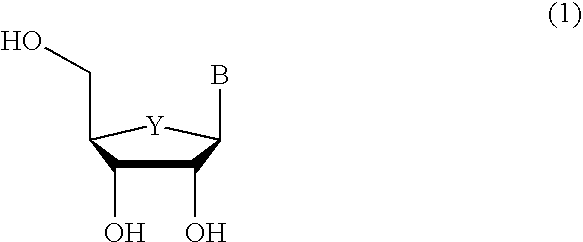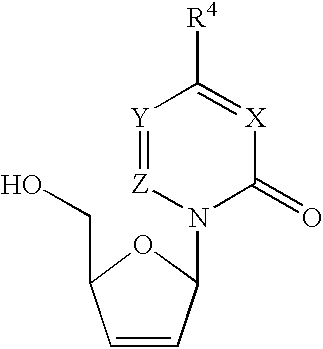Method for the synthesis of 2′,3′-dideoxy-2′,3′-didehydronucleosides
a technology of d-d4fc and synthesis method, which is applied in the field of synthesis of d-d and l2′, 3 ′didehydro2′, 3 ′dideoxynucleosides, can solve the problems of inefficient synthesis of d-d4fc, inability to use purine nucleosides in the production of purine nucleosides, and inability to efficiently produce enantiomeric forms
- Summary
- Abstract
- Description
- Claims
- Application Information
AI Technical Summary
Benefits of technology
Problems solved by technology
Method used
Image
Examples
example 1
[0591]Preparation of 5′-O-(α-Acetoxyisobutyryl)-3′-O-acetyl-2′-Bromo-2′-deoxy-5-fluorocytidine (II*-a) and 5′-O-(α-Acetoxy-isobutylyl)-2′ O-acetyl-3′-bromo-3′-deoxy-5-fluorocytidine (II-a) from 5-fluorocytidine using 2-acetoxy-2-methyl-propionyl bromide as the acyl halide and EtOAc / CH3CN as the solvent.
[0592]Step (1). To a suspension of 5-fluorocytidine ((I), 26.1 g, 0.1 mole) in EtOAc (200 mL) and CH3CN (50 mL) was added 2-acetoxy-2-methyl-propionyl bromide (84.4 g, 0.4 mol) dropwise at room temperature under N2. The resulting reaction mixture was then stirred at room temperature for 24 hours. The mixture was cooled to about 4° C. in an ice-water bath. An aqueous KHCO3 solution (˜10%) was added until the mixture reached a pH of about 8.0. The organic layer was separated and the aqueous layer was extracted one time with ethyl acetate. The combined organic solution was washed with brine. Concentration afforded the major products,(II-a) and (II*-a), and the minor products, (II-b) and ...
example 2
Preparation of (II-a) and (II*a) from 5-fluoro-cytidine using 2-acetoxy-2-methyl-propionyl bromide as the acyl halide and CH3CN as the solvent.
[0595]Step (1). To a suspension of 5-fluorocytidine ((I), 5.2 g, 0.02 mole) in CH3CN (40 mL) was added 2-acetoxy-2-methyl-propionyl bromide (16.7 g, 0.08 mol) dropwise at room temperature under N3. The resulting reaction mixture was then stirred at room temperature for 18 hours. The mixture was diluted with EtOAc (80 mL) and then cooled to about 4° C. in an ice-water bath. An aqueous KHCO3 solution (˜10%) was added until the mixture reached a pH of about 8.0. The organic layer was separated and the aqueous layer was extracted two times with ethyl acetate. The combined organic solution was washed with brine. Concentration afforded the major products, (II-a) and (II*-a), and the minor products, (II-b) and (II*-b), as a solid in a ratio of 8.7:1 (6.8 g, 69%).
example 3
Preparation (II-a) and (II*-a) from 5-fluorocytidine using 2-acetoxy-2-methyl-propionyl bromide as the acyl halide and CH2Cl2 as the solvent, in the presence of Et4NBr.
[0596]Step (1). To a suspension of 5-fluorocytidine ((I), 2.61 g, 0.01 mole) and Et4NBr (6.3 g, 0.03 mol)in CH2CH2 (20 mL) was added 2-acetoxy-2-methyl-propionyl bromide dropwise (9.3 g, 0.03 mol) at room temperature under N2. The resulting reaction mixture was then stirred at room temperature for 18 hours. The mixture was cooled to about 4° C. in an ice-water bath. An aqueous KHCO3 solution (˜10%) was added until the mixture reached a pH of about 8.0. The organic layer was separated and the aqueous layer was extracted one time with CH2Cl2. The combined organic solution was washed with brine. Concentration afforded the major products, (II-a) and (II*-a), and the minor products, (II-b) and (II*-b), as a solid in a ratio of 4.3:1 (4.17 g, 84%).
PUM
| Property | Measurement | Unit |
|---|---|---|
| temperature | aaaaa | aaaaa |
| temperature | aaaaa | aaaaa |
| temperature | aaaaa | aaaaa |
Abstract
Description
Claims
Application Information
 Login to View More
Login to View More - R&D
- Intellectual Property
- Life Sciences
- Materials
- Tech Scout
- Unparalleled Data Quality
- Higher Quality Content
- 60% Fewer Hallucinations
Browse by: Latest US Patents, China's latest patents, Technical Efficacy Thesaurus, Application Domain, Technology Topic, Popular Technical Reports.
© 2025 PatSnap. All rights reserved.Legal|Privacy policy|Modern Slavery Act Transparency Statement|Sitemap|About US| Contact US: help@patsnap.com



